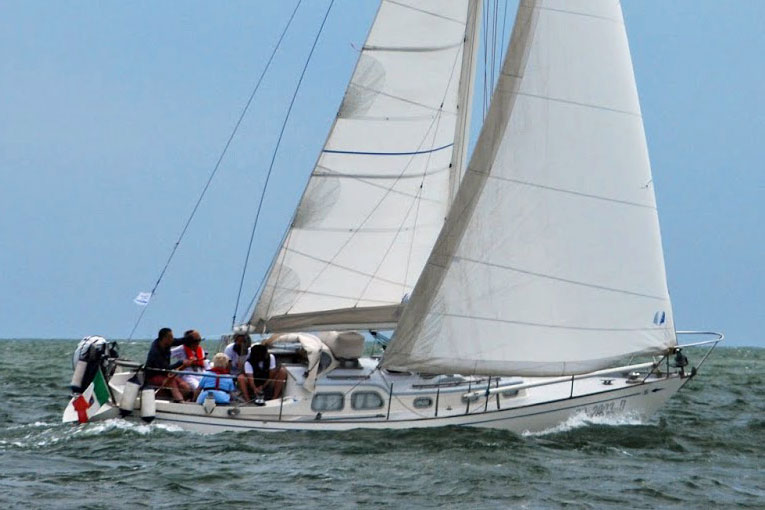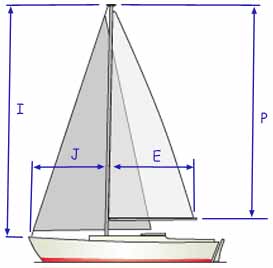- Home
- Cruising Yachts 30' to 35'
- S&S 34
The S&S 34 Sailboat
The S&S 34 is a cruising and racing fibreglass monohull sailboat that was designed by Olin Stephens from Sparkman and Stephens. It has a skeg-hung rudder and a Bermuda rig with a large, overlapping headsail. It is a proven cruising yacht that is well suited for short-handed sailing, and also a successful racing yacht that has won many prestigious events.
 An S&S 34 powers to windward under full sail
An S&S 34 powers to windward under full sailPublished Specification for the S&S 34
Underwater Profile: Fin keel & Skeg-Hung Rudder;
Hull Material: GRP (Fiberglass);
Length Overall: 33'5" (10.2m);
Waterline Length: 24'2" (7.4m);
Beam: 10'1" (3.1m);
Draft: 5'9" (1.8m);
Rig Type: Masthead sloop;
Displacement: 9,195lb / 4,171kg;
Designer: Sparkman & Stephens;
Builder: Winfield & Partners/Aquafibre (UK);
Year First Built: 1968;
Owners Association: Sparkman & Stephens Owners Association
Sail Areas & Rig Dimensions
I: 12.2 m (40.0 ft)
J: 4.0 m (13.1 ft)
P: 10.7 m (35.1 ft)
E: 3.4 m (11.2 ft)
Mainsail Area: 17.9 m² (192.5 ft²)
Foresail Area: 24.2 m² (260.5 ft²)
Total Sail Area: 42.1 m² (452.5 ft²).
Published Design Ratios for the S&S 34
- Sail Area/Displacement Ratio: 16.5 - The S&S 34 has a Sail Area/Displacement Ratio of 16.5. This indicates that the boat has reasonably good performance capability. It is not underpowered and suggests it can maintain a decent speed and agility under sail. This ratio falls into the range that indicates reasonably good performance (16 to 20).
- Ballast/Displacement Ratio: 58.7 - With a Ballast/Displacement Ratio of 58.7%, the S&S 34 is quite stiff, implying that it can stand up well to strong winds without excessive heeling. This high ratio suggests the boat will be stable and perform well in various wind conditions. However, without information on the ballast's location, we can't fully assess its stiffness. A deeper keel with concentrated ballast would further enhance stability.
- Displacement/Length Ratio: 291 - The S&S 34 has a Displacement/Length Ratio of 291, placing it in the Heavy Displacement category (275-350). This means the boat is relatively heavy for its length and will require more sail area to reach hull speed compared to lighter displacement boats. Heavier displacement boats like this one are typically more comfortable in rough seas and provide a steadier ride.
- Comfort Ratio: 24.3 - The Comfort Ratio of 24.3 suggests that the S&S 34 will have moderate motion comfort. It falls within the range (20 to 30) typically associated with coastal cruisers with moderate stability. This indicates that the boat will handle the typical pitch, roll, and corkscrew motions encountered in coastal cruising quite well, providing a reasonable level of comfort for the crew.
- Capsize Screening Formula: 1.9 - With a Capsize Screening Formula of 1.9, the S&S 34 is well-suited for ocean passages. Since the value is at 2.0 or lower, it indicates the boat has good blue water capabilities and is less vulnerable to capsizing in rough offshore conditions. The lower the value, the better, and 1.9 suggests that the boat should handle well in heavy seas.
Summary: The S&S 34 sailboat is designed for good performance with decent speed and agility thanks to its Sail Area/Displacement Ratio. It has a high Ballast/Displacement Ratio, indicating good stability and stiffness, though the exact nature of its stability depends on ballast placement. Being a heavy displacement boat, the S&S 34 is expected to be comfortable in rough seas and provides a moderate level of motion comfort consistent with coastal cruising. Its Capsize Screening Formula underlines its suitability for blue water sailing, making it a solid choice for long ocean passages.
Design Ratios: Notes of Caution...
- The Sail Area/Displacement Ratio (SA/D): This ratio provides an estimate of the sail power relative to the boat's weight, which can indicate potential speed in various wind conditions. But it doesn't account for the efficiency of the sail plan, the rigging, or the skill of the crew. Real-world performance can vary significantly based on these factors.
- The Ballast/Displacement Ratio (B/D): This ratio gives an idea of the boat's stability and stiffness, which is crucial for handling and safety. But it doesn't consider the distribution of the ballast or the hull shape, both of which can greatly affect stability. A high B/D ratio alone doesn't guarantee a stable boat if the ballast is poorly distributed.
- The Displacement/Length Ratio (D/L): This ratio helps predict the boat's speed potential and its behaviour in different sea conditions. But it doesn't account for the hull design or the boat's overall weight distribution. Two boats with the same D/L ratio can perform very differently if their hull shapes are different.
- The Comfort Ratio (CR): This ratio estimates the boat's motion comfort in a seaway, which is important for long passages. But it doesn't consider the boat's interior layout, which can also affect comfort. Additionally, personal tolerance to motion varies, so a boat that is comfortable for one person might not be for another.
- The Capsize Screening Formula (CSF): This formula assesses the likelihood of a boat capsizing in heavy seas, which is critical for offshore safety. But it doesn't take into account the boat's handling characteristics or the skill of the crew. A boat with a low CSF can still capsize if poorly handled in severe conditions.
General Limitations
- Static Nature: These ratios are static measurements and don't account for dynamic factors like wave action, wind gusts, or crew actions.
- Simplification: They simplify complex interactions into single numbers, which can be misleading. Real-world performance is influenced by a multitude of factors that these ratios can't fully capture.
- Context: The context in which the boat is used (e.g., coastal cruising vs. offshore racing) can greatly affect how these ratios should be interpreted.
In summary, while these ratios provide valuable insights into the theoretical performance characteristics of a sailboat, they should be used as part of a broader assessment that includes practical experience, sea trials, and expert advice.
This article was written with the assistance of Gemini, a large language model developed by Google. Gemini was used to gather information, summarize research findings, and provide suggestions for the content and structure of the article.
Recent Articles
-
Is An SSB Marine Radio Installation Worth Having on Your Sailboat?
Apr 14, 25 02:31 PM
SSB marine radio is expensive to buy and install, but remains the bluewater sailors' favourite means of long-range communication, and here's why -
Correct VHF Radio Procedure: Your Questions Answered
Apr 14, 25 08:37 AM
Got a question about correct VHF radio procedure? Odds are you'll find your answer here... -
VHF Marine Radio; Which One is Right for Your Boat?
Apr 14, 25 05:09 AM
If you're looking to buy a VHF Marine Radio the choice can be a bit overwhelming. So what should it be, a fixed VHF or a handheld VHF? Maybe one with AIS or GPS built in perhaps?













